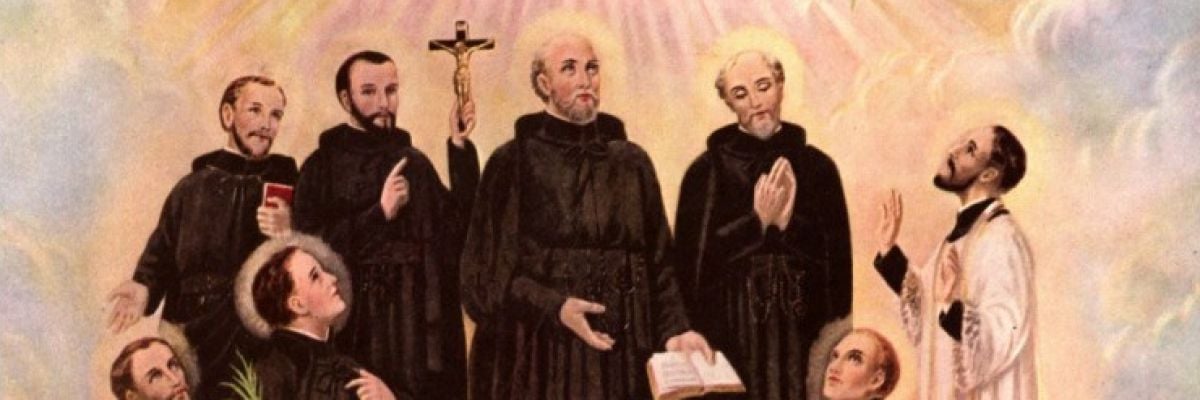
Nestled in the beautiful Mohawk Valley of Upstate New York is the hamlet of Auriesville, the home of one of the most sacred sites in North America. The Shrine of Our Lady of the Martyrs, now a welcoming and engaging Catholic pilgrimage destination, is set within what was originally the Mohawk village of Ossernenon,
The holy site, which grandly overlooks of the Mohawk River and Valley, does not immediately come to mind when one considers the pantheon of holy Catholic places, but it was there in the seventeenth century that three members of the Jesuit order were martyred for the Faith. Along with five other Jesuits who were martyred in Canada, these saints are known as the North American Martyrs.
The story of the North American Martyrs, whose feast day is October 19, begins in the sixteenth century, when Jacques Cartier, the French explorer, first sailed down the Saint Lawrence Seaway. He was followed years later by Samuel de Champlain, who established Quebec City. By the mid-eighteenth century, the rapidly-growing colony of New France was wealthy and populous. French missionaries, especially the Jesuits, soon followed in order to evangelize the indigenous peoples. Among the many tribes in the area, the Algonquin and Huron were the most receptive to the Faith, so missionary activity focused on them. Still, converts were few and many of the Indians were hostile to the missionaries, whom they blamed for any calamity that might befall the tribe or one of its members.
Missionary work among the native peoples was both grueling and dangerous. The journey from the main French colonial outposts to Huronia was 800 miles, and missionaries who traveled it faced many natural obstacles as well as hostile tribes. In the mid-seventeenth century, the warlike Iroquois Confederacy (comprising the Mohawks, Senecas, Oneidas, Onondagas, and Cayugas) began a concerted campaign of violence against the Hurons, which placed the Jesuit missionaries in grave danger.
Despite the risks, priests and lay workers continued their evangelization efforts among the Hurons. The first Jesuit to give his life as a martyr in New France was René Goupil (1608–1642), a lay Jesuit and trained surgeon. Captured by the Mohawks while taking supplies from Quebec to Huronia, Goupil and Father Isaac Jogues were taken to the village of Ossernenon, where they were tortured. Goupil suffered terribly: his fingernails were ripped out and his fingers were crushed. Several weeks later, on September 29, 1642, he was tomahawked to death for having made the Sign of the Cross before eating. Fr. Jogues buried his friend’s body in a ravine a short distance from the village. Today, visitors can walk through this sacred ravine reading Fr. Jogues’s account of Goupil’s martyrdom and burial. It is a holy and moving experience.
Fr. Isaac Jogues (1607–1647), the fifth of nine children, decided at age seventeen to enter the Society of Jesus. Ordained in 1636, Fr. Jogues would volunteer for the missions in New France, eventually traveling extensively in what was to become New York State. When taken captive with Goupil, Fr. Jogues suffered in captivity for a year before he was able to escape. After returning to France, accounts of his harrowing escape and missionary travels made him something of a celebrity. Although he could have continued to live comfortably in France, Fr. Jogues’s zeal for souls impelled him to request reassignment to New France, which was granted. Unfortunately, his second stint in the New World was short-lived, as he was once again captured by the Mohawks, and returned to the site of his imprisonment and his friend’s death. Undeterred at the rough treatment from the Mohawks, Fr. Jogues trusted in the Lord and heroically met his end in Ossernenon, along with the lay Jesuit worker, Jean de la Lande, in 1646.
Two years later, another Jesuit suffered martyrdom in North America. Antoine Daniel (1601–1648) provided a lasting contribution to the evangelization of the Hurons by translating the Lord’s Prayer into their native language. His time among the Hurons was short-lived, however, as the Iroquois attacked the village where he was staying. Fr. Daniel had just finished celebrating Mass when the attack commenced. During the chaos, Fr. Daniel ministered and comforted the dying and wounded Hurons until he was shot with arrows and musket balls. As he lay dying, he called out the name of Jesus. The Iroquois threw his body into a burning house.
The following year, 1649, was the bloodiest time for Jesuit missionaries on North America as four additional martyrs joined the heavenly host. Father Jean de Brébeuf (1593–1649) was one of the first missionaries to arrive in New France in 1625 and wrote a set of instructions for missionaries that reflected his deep love and concern for the Huron people. Fr. Jean told his fellow and future missionaries to love the Hurons unconditionally, to eat the food they offered, to carry something during portages, and to always appear cheerful. He also published a catechism and a dictionary in the Huron language for use by other missionaries.
Fr. Jean’s time among the Hurons was told in letters sent back to France that were compiled and published under the title Huron Relation 1635. When the Iroquois declared war on the Hurons in March 1649, Fr. Jean was captured by a Mohawk war party along with Gabriel Lalement (1610–1649), who had been in New France for only six months. Fr. Jean was beaten, tied to a stake, and had scalding water poured over his head in a mockery of baptism. Additionally, a collar of red-hot tomahawk heads was placed around his neck and a red-hot iron was thrust down his throat. Despite these horrific punishments, he did not utter a word of protest throughout the ordeal. The Jesuit lay worker serving with Fr. Jean, Gabriel Lalement, had his eyes gouged out. In the empty sockets, the Mohawks placed burning coals. Finally, a hatchet blow to the head killed him. When both men died, the Mohawks cut out their hearts and ate them.
The last two Jesuit martyrs were Father Charles Garnier (1606–1649) and Father Nöel Chabanel (1613–1649). Newly-ordained Fr. Garnier served among the Hurons and soon contracted smallpox. He was killed in December 1649 during an Iroquois raid. The last Jesuit to die in New France, Fr. Chabanel struggled mightily to learn the Huron language. Although, his lack of language skills provided an excuse to return home, Fr. Chabanel vowed to remain in Huronia. Louis Honareenhax, a Huron apostate, killed Fr. Chabanel because he believed his conversion was the cause of calamities suffered by his family and tribe.
The blood of the North American Martyrs proved to be the seed of a future saint, as ten years after the death of Saints Isaac Jogues and Jean de la Lande, a young Mohawk girl was born in the village of Ossernenon. Kateri Tekakwitha (1656–1680) was the daughter of an Algonquin mother and a Mohawk father. When she was four years old, her parents and brother died of smallpox, which she also contracted. The disease left her disfigured with scars on her face and impaired eyesight. As a result, Kateri used to walk into objects, so the villagers called her “Tekakwitha,” or “she who bumps into things.” French Jesuits evangelized the tribe and Kateri embraced the Faith at the age of eighteen. Ostracized for her conversion, Kateri moved to a village near Montreal and died at the young age of twenty-four. Today, this beloved saint is known as the “Lily of the Mohawks.”
The story of the North American Martyrs is one of adventure, heroism, and deep and abiding love for Christ and his Church. Modern-day Catholics can learn much from their zeal and courage and can even visit the holy ground where they spilled their blood.



